 |
 |
 |
 |
 |
 |
|
View of Pompey's Pillar with
Alexandria in the background in c.1850 |
View over the modern city of
Alexandria in c.1880 |
Bird's eye view over Alexandria in
around 1870 |
WH Bartlett, views of Alexandria in
the 1830's |
Engraving by Fragonard of the painting of Augustus
(Octavian) visiting Alexander's tomb in Alexandria by Sebastien
Bourdon (c. 1643, Louvre) |
J-F Cassas, external view of the
Rosetta Gate, drawn in 1785 (published in 1799) |
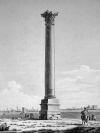 |
 |
 |
 |
 |
 |
|
Description de l'Egypte, Antiquites
V, Plate 34, Pompey's Pillar, drawn c.1798, published in the
Panckoucke edition of 1821-9 |
Description de l'Egypte, Antiquites
V, Plate 32, Cleopatra's needles and the Tower of the Romans, drawn
c.1798, published in the Panckoucke edition of 1821-9 |
Cornelius de Bruyn,
view of Pompey's Pillar with Alexandria in the background, 1681 |
Cornelius de Bruyn,
view of the great harbour from a little behind the shoreline, 1681 |
Edward Daniel Clarke,
The courtyard of the Attarine Mosque in 1798 after Vivant Denon,
from The Tomb of Alexander, Cambridge, 1805 |
Description de l'Egypte, Antiquites
V, Plate 35, View of the Attarine Mosque looking northwards across
Canopic Way, drawn c.1798, published in the Panckoucke edition of
1821-9 |
 |
 |
 |
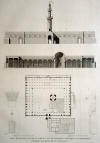 |
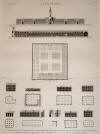 |
 |
|
Description de l'Egypte, Antiquites
V, Plate 42, Plans and views of a catacomb on the coast to the west
of Alexandria, drawn c.1798, published in the Panckoucke edition of
1821-9 |
Description de l'Egypte, Antiquites
V, Plate 39 (top), Courtyard of the Attarine Mosque with the chapel
containing the sarcophagus, drawn c.1798, published in the
Panckoucke edition of 1821-9 |
Description de l'Egypte, Antiquites
V, Plate 39 (bottom), Plan and cross-section of the ancient stadium
behind Pompey's Pillar, drawn c.1798, published in the Panckoucke
edition of 1821-9 |
Description de l'Egypte, Antiquites
V, Plate 38, Section and plan of the Attarine Mosque, drawn c.1798,
published in the Panckoucke edition of 1821-9 |
Description de l'Egypte, Antiquites
V, Plate 37, The Mosque of a Thousand Columns (Septante) and ancient
subterranean cisterns, drawn c.1798, published in the Panckoucke
edition of 1821-9 |
Description de l'Egypte, Antiquites
V, Plate 43, Small Pharos monument and remains of a temple enclosure
at Taposiris (Tomb of Osiris) to the west of Alexandria, drawn
c.1798, published in the Panckoucke edition of 1821-9 |
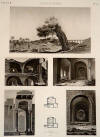 |
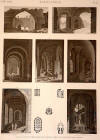 |
 |
 |
 |
 |
|
Description de l'Egypte, Etat Moderne II,
Plate 91, Pilgrims' Tree and Aqueduct, views of Alexandrian ruins,
drawn c.1798, published in the Panckoucke edition of 1821-9 |
Description de l'Egypte, Etat Moderne II,
Plate 90, Views and plans of towers in the circuit of the old walls,
drawn c.1798, published in the Panckoucke edition of 1821-9 |
Description de l'Egypte, Etat Moderne II,
Plate 89, Views of sections of the old walls, drawn c.1798,
published in the Panckoucke edition of 1821‑9 |
Description de l'Egypte, Etat Moderne,
Plate 87, Views of Qait Bey Fortress and the "Diamant" Rock, drawn
c.1798, published in the Panckoucke edition of 1821-9 |
Description de l'Egypte, Etat Moderne II,
Plate 86, View across the Great Harbour towards Qait Bey fortress,
drawn c.1798, published in the Panckoucke edition of 1821-9 |
Description de l'Egypte, Etat Moderne II,
Plate 97, Panoramic view across the Great Harbour and Kom el-Dikka
from the parade ground, drawn c.1798, published in the Panckoucke
edition of 1821-9 |
 |
 |
 |
 |
 |
 |
|
Luigi Mayer, aquatint
showing the Attarine Mosque in c.1792 looking west down Canopic Way
with ancient granite pillars standing and fallen along the line of
the ancient street (published 1801-4) |
Luigi Mayer, aquatint looking north
at a bridge across the Calish/ Canopic Canal with Pompey's Pillar in
the background drawn in c.1792 (published 1801-4) |
Luigi Mayer, aquatint showing the
Attarine Mosque in c.1792 looking east down Canopic Way with ancient
granite pillars then still standing (published 1801-4) |
Cleopatra's needles in an engraving
in the Graphic of November 20th 1875 just prior to the
removal of the fallen obelisk to London |
Description de l'Egypte, Etat Moderne II,
Plate 98, Panoramic view across the Old City from the parade ground,
drawn c.1798, published in the Panckoucke edition of 1821-9 |
Luigi Mayer, aquatint showing
catacombs on the coast to the west of Alexandria in c.1792
(published 1801-4) |
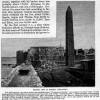 |
 |
 |
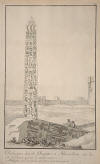 |
 |
 |
|
Engraved version of a photo of the
standing obelisk and the remodelled wall incorporating the Tower of
the Romans in the early 1870's |
Woodcut of Alexandria from the
Nuremberg Chronicle (1493) - the view is evidently invented on the
basis of slight knowledge of ancient descriptions - the church is
probably St Mark's |
Captain Frederick Norden, view of the
great harbour looking across to Qait Bey fortress, 1737 |
Captain Frederick Norden, view of Cleopatra's
Needles from the west, 1737 |
Photograph on a glass plate from
c.1880 of the standing obelisk of Cleopatra's Needles |
Nabi Daniel mosque and Kom el-Dikka
with Fort Cretin in a postcard of the early 20th century |
 |
 |
 |
 |
 |
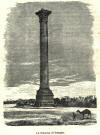 |
|
Luigi Mayer, aquatint showing
Pompey's Pillar looking north towards Alexandria in c.1792
(published 1801-4) |
Luigi Mayer, aquatint showing the
outer portal of the Rosetta Gate from the inside in c.1792
(published 1801-4) |
Luigi Mayer, aquatint showing
Cleopatra's Needles (the Caesareum Obelisks) in c.1792 with the
Tower of the Romans - the fallen obelisk is now on the Thames
Embankment in London, whilst that then standing is now in Central
Park in New York (published 1801-4) |
Luigi Mayer, aquatint showing the
great harbour looking north towards Qait Bey fortress on the site of
the Pharos in c.1792 (published 1801-4) |
Luigi Mayer, aquatint showing a
mosque with an ancient pillar built into it looking east down
Canopic Way towards the Rosetta Gate in c.1792 (published 1801-4) |
Pompey's Pillar in c.1880 |
 |
 |
 |
 |
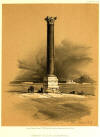 |
 |
|
Thomas Walsh, view of Qait Bey
fortress in 1801, published in History of the Late Campaign in Egypt
(1803) |
Thomas Walsh, view of Alexandria from
the east during the siege of 1801, published in History of the Late
Campaign in Egypt (1803) |
H. Showmer, imaginative
reconstruction of Caesar's (probably Octavian's) visit to
Alexander's tomb in Alexandria, engraved from a painting (late 19th
century) |
Engraving of c.1840 by Rouargue of a
view of the Nabi Daniel Mosque from Kom el-Dikka by WH Bartlett done
in c.1837 |
David Roberts, view of Pompey's
Pillar in the mid-1840's (note Kom el-Dikka mound in the
background), published 1854 |
David Roberts, view of Cleopatra's
Needles in the mid-1840's (note remodelling of the walls done 20
years earlier by Galice Bey), published 1854 |
 |
 |
 |
 |
 |
 |
|
David Roberts, view of Alexandria
from the sea in the mid-1840's, published 1854 |
Ancient columns on the beach of Ras-el-Tin
in about 1880 |
Thomas Walsh, views of the Rosetta
Gate and other parts of the walls, published in History of the Late
Campaign in Egypt (1803) |
Engraving of Cleopatra's
Needle standing in Alexandria in c.1850, looking west, published in
c.1890 |
An albumen photo looking
west showing Cleopatra's needle (now in Central Park, New York),
whilst it
still stood in Alexandria in the 1870's |
Small
mosque in view of Alexandria from the Illustrated London News 1862
with a part of the Nabi Daniel
mosque in the background
|
 |
 |
 |
 |
 |
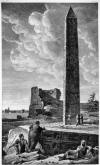 |
Reconstruction of
ancient Alexandria based on the accounts of ancient writers by
D'Anville and
Rollins, published in 1808 |
Fallen
needle (obelisk) rolled down the Alexandrian shore packed in a
cylinder ship for sailing to London in 1877 |
Launch of the needle
ship Cleopatra from the beach at Alexandria in 1877 |
Preparing the fallen
needle for shipping to London in 1877 (the Greek owner of the land
Signor Demetri had threatened to break the needle up for building
stone) |
Construction of the
cylinder ship Cleopatra around the obelisk for shipping to London in
1877 |
Obelisk attributed to Cleopatra at Alexandria, view of the ruins of
the library of the Ptolemies and of the Museion, aspect from the sea
of the little Pharillon, drawn by Louis-Francois Cassas in 1785 and
engraved and published in Paris in 1799 |
 |
 |
 |
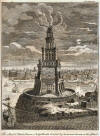 |
 |
 |
|
Nineteenth century
sketch in watercolour and pencil after(?) David Roberts (1838)
inscribed Cleopatra's Needle, Alexandria on the back |
A
view from the vicinity of Kom el Dikka looking west towards fort
Qait Bey c. 1856 |
A
view of Clepatra's Needles in 1853 from the Illustrated London News |
A
famous imaginative reconstruction of the Pharos lighthouse in
Alexandria published in 1764 |
View looking east down Canopic Way
drawn by L-F Cassas during his visit to Alexandria in 1785: this
version is a full size copy engraved by J. Dadley (1758-1819) in
about 1810 of the French first edition of 1799 |
View looking west past Cleopatra�s
needle from the top of the Tower of the Romans, published by Henri
Chatelain in his Atlas Historique in 1719 |
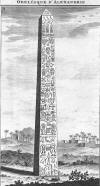 |
 |
 |
 |
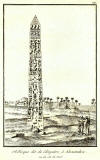 |
 |
|
View looking southwards to Kom el-Dikka
past Cleopatra�s needle, published by Henri Chatelain in his Atlas
Historique in 1719 |
View of the interior of one of the
ancient towers in the curtain walls of Alexandria, published by
Henri Chatelain in his Atlas Historique in 1719 |
View
of Cleopatra�s Needles from Clarke�s Travels, presumably from a
sketch made during his visit in 1801 |
Woodcut view of Alexandria with authentic details from/by Foresti di
Bergamo, Supplementum Chronicarum of 1520; is the tower on the
peninsula the Pharos or an exaggeration of the minaret of Qait Bey
fortress, built on its site in the 1470�s? |
Engraving of Cleopatra�s Needle in
Alexandria viewed from the north side looking south towards Kom el-Dikka,
drawn by Captain Frederick Norden in 1737 |
View of
the
Nabi Daniel mosque from Kom el-Dikka in a postcard
mailed in 1908 |
 |
 |
 |
 |
 |
 |
|
View looking westwards across the
modern Shallalat Gardens showing the remains of the ancient corner
tower of the old walls on the far bank of the lake in the early 20th
century |
Reproduction in the Illustrated
London News of 1867 of a lithograph by Hildebrandt published in 1865
looking westwards past Cleopatra�s Needle across the harbour to Qait
Bey Fortress |
Chromolithograph of a watercolour by
Hildebrandt painted in 1862 looking westwards past Cleopatra�s
Needle across the harbour to Qait Bey Fortress |
The Indian contingent
of the British army overlooking Alexandria from the east in 1801 in
an engraving by Edward Orme |
View looking west from Kom el-Dikka
published in c.1883 but dating to c.1820 since the Nabi Daniel
Mosque is not yet built but the palace is visible at Ras el-Tin in
the distance |
Albumen photo from c.1870 looking east past
Cleopatra�s Needle and showing the remains of the ancient Tower of
the Romans at the shore |
 |
 |
 |
 |
 |
 |
|
Cornelius de Bruyn, view
across Alexandria looking west from the Tower of the Romans with
Cleopatra�s Needle in the foreground, 1681 (published 1698) |
Cornelius de Bruyn, interior of a
tower in the ancient walls of Alexandria, 1681 (published 1698) |
Cornelius de Bruyn, interior of a tower in Alexandria, 1681
(published 1698)
|
Cornelius de Bruyn, ancient ruins at
the harbour front of Alexandria, which were said to be the Palace of
Cleopatra, 1681 (published 1698) |
Cornelius de Bruyn, westwards view of
the western part of old Alexandria with the watchtower keep on its
hillock, 1681 (published 1698) |
Cornelius de Bruyn, view
of ruins in old Alexandria, 1681 (published 1698) |
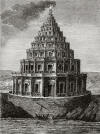 |
 |
 |
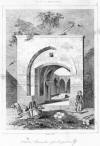 |
 |
 |
|
Imaginative but inaccurate
re-creation of the Pharos lighthouse at Alexandria (1872) |
Reconstruction of the Mausoleum at
Halicarnassus closely based on accurate ancient descriptions (1872)
� this building was probably the inspiration for many of the royal
tombs in ancient Alexandria |
�View of Alexandria from the vicinity
of Kom El-Dikka dating to about 1835, which resembles one of Vivant
Denon�s views over Alexandria published in his Travels in Egypt in
1801-1803� |
�The Okel near the Great Harbour of
Alexandria, which was a medieval building constructed using ancient
columns with Corinthian and Ionic capitals, by Lemaitre, 1848� |
View of
the New Town section of the shoreline of the Great Harbour of
Alexandria in 1737 by Captain Frederick Norden: a is the Sa�que;
b are old towers and bastions of the Saracen walls; c is Pompey�s
Pillar; d is the French hostel; e is the customs post; f are the
minarets of the mosques; g is an English vessel |
View of the Pharillon or Fanal in
1737 by Captain Frederick Norden: b is said to be the ruins of the
Library of the Ptolemies; c is the promontory of the Fort of Aboukir |
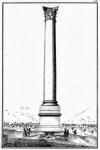 |
 |
 |
 |
 |
 |
|
View of Pompey�s Pillar in 1737 by Captain
Frederick Norden |
View of the shoreline of the Great
Harbour of Alexandria in 1737 with the Tower of the Romans and
Cleopatra�s Needle by Captain Frederick Norden: b is the Temple of
Caesar; c is the Church of St Mark; d is the Churches of St George
and St Catherine |
View of Cleopatra�s Needles and the
Tower of the Romans circa 1825 after P. Bohmanns |
View of the Rosetta Gate of Alexandria after P.
Bohmanns, dating to circa 1825 just before the remodelling of the
walls by Galice Bey
|
Gouache painting of the Pharos of
ancient Alexandria based on the reconstruction of Hermann Thiersch
published in 1909 |
A postcard showing a view of the
Tower of the Romans on the shore of the Great Harbour of Alexandria
looking east in about 1900 |
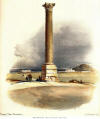 |
 |
 |
 |
 |
 |
|
David Roberts, view of
Pompey's Pillar in the mid-1840's: this is the aquatinted first
edition version published in 1846 |
A view of Alexandria looking west
across the Great Harbour published in 1808, but seemingly based on a
view circa 1600 |
Views of Alexandria from the
Mediterranean Sea in 1798 from drawings by Vivant Denon (1802) |
Views of ancient ruined columns and
the Tower of the Romans with Cleopatra's Needles in 1798 from
drawings by Vivant Denon (1802) |
Fort Qait Bey and a panorama of the
Great Harbour from Kom El-Dikka in 1798 from drawings by Vivant
Denon (1802) |
Exterior View of the Ancient Wall of
Alexandria with Cleopatra�s Needle, Aquatint by Luigi Mayer, drawn
circa 1792, published in London circa 1802 |
 |
 |
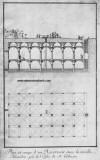 |
 |
 |
 |
|
View across the Great Harbour towards
fort Qait Bey on the site of the Pharos from a sketch of 1785 by L-F
Cassas, engraved by Garreau and published 1799(?) |
The Baths of Cleopatra at Alexandria
drawn by Luigi Mayer in or before 1792 and published as an aquatint
in London in 1802 |
An ancient cistern
near the Church of St Catherine in Alexandria drawn by Norden in
1737 and published in Paris in 1755 |
An antique watercolour
signed �JML� depicting a view across the Great Harbour of Alexandria
in the 19th century from a beach to the east of the city |
This is an imaginative reconstruction of the Pharos of Alexandria,
one of the Seven Wonders of the World series of engravings by Galle
dating to 1572 and based on the paintings of the earlier 16th
century by Martin Heemskerck |
View of ruins in the shoreline of the Great Harbour at Alexandria in
or before about 1792 drawn by Luigi Mayer and (speculatively)
captioned the Ptolomean Library � published as an aquatinted
engraving by R Bowyer in London in 1802 |
 |
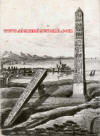 |
 |
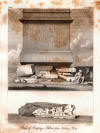 |
 |
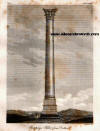 |
|
A panorama of Alexandria published in 1692 loosely based on the
Braun & Hogenberg plan of the city from 1575 |
An original drawing from about 1800 looking west past Cleopatra�s
Needles in the foreground across the Great Harbour of Alexandria
towards Qait Bey fortress on the site of the Pharos |
Engraving from an early eighteenth century drawing reconstructing
the Pharos overlooking the Great Harbour of Alexandria from ancient
descriptions |
Base of Pompey�s Pillar after Norden
(1801) |
Diagram of the base of Pompey�s Pillar (1801) |
Engraving of Pompey�s Pillar after Dalton (1801) |
 |
 |
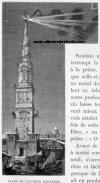 |
 |
 |
 |
|
Panoramic view of the site of Pompey�s Pillar from Aegyptiaca (1801) |
Alexandrian catacombs still choked with debris (1883) |
Imaginative reconstruction of the Pharos lighthouse (1883) |
Engraved view of the ruins of the ancient walls of Alexandria (1883) |
A very early (c. 1870) albumen photo of the Nabi Daniel Mosque in
Alexandria by the Zangaki Brothers - seemingly shows the mosque as
built by Mohammed Ali without later additions |
The still standing member of a pair of obelisks from Heliopolis,
transferred to Alexandria by Cleopatra and now in Central Park, New
York (19th century lantern slide taken in Alexandria in
about 1879)
|